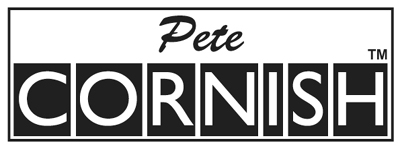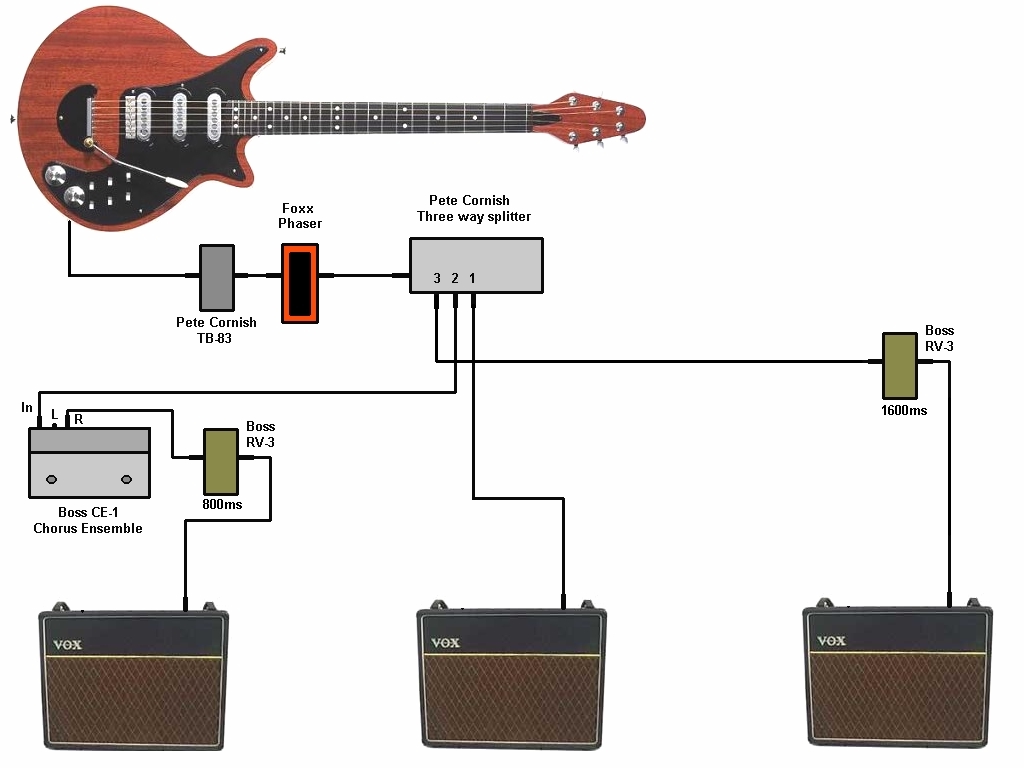
Unit 5, Silveroaks Farm, Hawkhurst Lane, Waldron, Heathfield, E.Sussex, UK, TN21 0RS
Tel (0)1435- 813393, International +44 1435 813393
VAT Reg. No. GB 241 7291 72

Unit 5, Silveroaks Farm, Hawkhurst
Lane,
Waldron, Heathfield, E.Sussex, UK, TN21 0RS
Tel (0)1435- 813393, International +44 1435 813393
VAT Reg. No. GB 241 7291 72
The Pete Cornish TB-83
By Mark Reynolds and Martin Pitcher.

Brian May's Rig Diagram
Many people know the history of the treble booster used by Brian May during his time with Queen so there is no need to detail the history in this review. You can read the story on the official Pete Cornish website:
TB-83:
http://www.petecornish.co.uk/vintage.html
Brian’s stage rigs:
http://www.petecornish.co.uk/queen.html
Other info:
http://www.brianmayworld.com/PeteCornish.html
This review is based on its use as it was intended. Our thoughts have been drawn from using a KZ Red Special (fitted with Adeson replica Tri-Sonics), the TB-83 in conjunction with a standard re-issue AC30 (normal channel) and also with the use of a Boss CE-1 Chorus Ensemble run in stereo with two AC30’s. All AC30’s had blue speakers.
The AC30’s have had all valves removed that are not associated with the normal channel. Incidentally, these modifications were also carried out by Pete Cornish when he was maintaining Queen’s equipment.
TB-83: This pedal is not a replica. It is the exact same unit that Pete Cornish has been making since the 1970's. He has never changed the PCB artwork, the components (except for minor substitutions when urgency of delivery was required), the layout or wiring. For those who would have known about it, the pedal has always been available.
It is built like a tank so there is no fear of the pedal becoming damaged, unless a large truck should wander across the stage and run over it!
The circuit board is encased in epoxy resin to protect the circuit and to eliminate unwanted interference. Other than the usual failures (jack sockets breaking down and battery clip being damaged) the parts are readily available from Pete Cornish and easily replaced.
It is housed in a rugged cast aluminum box and compact enough to fit in your guitar case and/or onto a pedal board. There are no controls to worry about. The TB-83 is designed to run first in line after the guitar.
The input jack
socket activates the battery so removal of this jack plug will save on battery
life when not in use.
Clean tones: The clean sparkling tone is achieved by using the Boss CE-1 Chorus Ensemble in stereo with two AC30’s. The bridge and middle pick-ups are used in phase and the guitar volume is rolled right back to eliminate the gain from the sound. This produces a rich sweet tone with plenty of sustain. Hitting the strings harder in this setting offers a slight crunch to the tone (very useful if working up to a heavier moment in a song).
Gentle use of the Sixpence from different angles offers an array tones which are almost bell like. The pedal creates this crystal clear tone which is quite amazing considering how powerful the pedal really is.
Picking the slow guitar part to “White Queen” is just perfect.
Rhythm tones: Taking the guitar volume slightly further to about a ¼ turn (or just over) creates a beautifully detailed springy rhythm tone. All strings can be heard clearly but has the punch to carry the backline of a song. It has plenty of sustain and but with a clean edge that creates a none messy sound that is perfect for a detailed picking rhythm that was quite often played by Brian.
When upstrokes are used the brightness is accentuated and the whole feel of this setting is quite amazing. Playing either lighter or heavier offers a wide range of rhythm tones. Quite notably, the beginning of “Now I’m Here” springs to mind when hitting the strings lightly.
Out of phase settings, such as neck and middle out of phase, creates a scratchy, nasal, honky tone such as the solo parts of “March of the black Queen”.
The pick attack is very obvious and depending on the angle, at which the coin is used, offers its own tone!
Midway tones: We must point out that this pedal is very powerful overall and (for want of a better description) gives you an extra quarter of a turn of boost on your guitar volume control.
This draws us to out of phase pick-up settings.
Naturally, out of phase settings are not quite as powerful as in phase pick-up settings.
So in order to get a substantial rhythm tone in an out of phase setting, the guitar volume would need to be a little higher to “fatten” the sound a little. From experiments, we have found that in the case of “Stone Cold Crazy” (which Brian has said he used the bridge and neck out of phase) to obtain that punch and growl of the chords, the volume control would be better set at about half way or just below. This gives the tone some bottom but also retains that out of phase scratchiness and bite. This gives an amazing raw edge to the sound. Scratchy and mean.
This setting also offers a heavier and slightly thicker overdriven tone. This is great for more mean sounding chords and riff work.
There is also plenty of sustain for a lower powered guitar solo at this point. Even low end single notes sound powerful and “celloish” with their sustain driving them along.
Lead level: From the “Rhythm tone” or “Midway tone” there is a big jump to full volume. Obviously this will offer a very powerful overdriven tone pushing the amps right over the top.
Full up, with bridge and middle in phase, gives a beautifully sweet and creamy overdriven tone with bags of sustain, whether playing power chords or lead riffs.
Obviously this is certainly most suitable for the neck and middle out of phase setting giving body and sustain to that screechy, warm tone for the real in your face lead breaks. Surprisingly the screech is ear piercing even with the underlying warmth. Hitting a chord or single note will run forever, climbing the octaves. The guitar feeds back very easily at these levels. It’s not uncontrollable and is wonderful to use for a long note. No need to hit the string more than once!
Conclusion: This pedal is incredibly versatile. It offers an amazing array of tones and, strangely, changes each time you play. There are so many ways of obtaining different tonal characters. Using the tone control on the guitar, pick attack, pick-up settings etc all add to create many complex sounds. The feedback sounds alone are unique.
The key words are richness and warmth. The richness never obscures the clarity.
Obviously using the Boss CE-1 Chorus Ensemble for a stereo spread creates a much more tuneful feel to the overall tone but this was employed by Brian for his live sound and studio work too.
This must be the most powerful treble booster we have ever tried.
The TB-83 is highly recommended for the original Queen sound.
Mark Reynolds and Martin Pitcher.